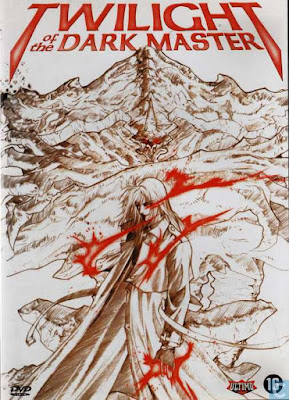 |
| From http://pics.filmaffinity.com/Kakurenbo_ Hide_and_Seek-632001110-large.jpg |
Director: Shuhei Morita
Screenplay: Shiro Kuro
Based on an original
idea
Cast
(English/Japanese): Dan Green/Makoto Ueki
(as Yaimao); Michael Sinterniklaas/Junko Takeuchi (as Hikora); Sean
Schemmel/Rei Naitou (as Noshiga); Tom Wayland/Mika Ishibashi (as Tachiji);
Veronica Taylor/Akiko Kobayashi (as Suku); Veronica Taylor/Masami Suzuki (as
Sorincha)
Viewed in English dub
version
 |
| From http://i.ytimg.com/vi/AR3AyHa7jzY/hqdefault.jpg |
Continuing on with the discussion
of (blog entry #3) A.LI.CE (1999)
and three dimensional animation in anime, there's also the subject of cel
shading, a technique which offers another visual palette in itself, turning
computer generated images into what looks like 2D comic book illustrations. Its
more well known for video games, making itself known through Jet Set Radio (2000), but it's been
used in other media and has been seen a few times in anime. Kakurenbo, in only twenty plus minutes,
follows a group of children who go to an abandoned and haunted city to play Otokoyo,
a game of hide or seek where one is safe if you follow the neon signs and
escape the various back alleys and tightly knit streets. Those who lose the
game are supposedly snatched away by demons. One boy Hikora joins this
particular game to find his sister Sorincha, who went missing after a previous
game of Otokoyo. What's found in the city for the players are legitimately monstrous.
 |
| From http://www.fahrenheitmagazine.com/wp-content/uploads/ 2015/01/KAKURENBO_FAHRENHEIT_4-620x300.jpg |
In terms of the animation style,
while it does show itself as being three dimensional animation on a lower
budget, this is a very good example of practical and imaginative use of such a
technique. Cel shading allows three dimensional animation to have a character
to it, vivid in primary colours or at least the look of a cartoon with a visual
dynamic to it. While a work from around the same time like Galerians: Rion (2002, which was released in the West in 2004) was
already doomed to become dated, using the three dimensional animation style of A.LI.CE, Kakurenbo despite some blemishes still looks very good now through
its distinct appearance. Wisely, to avoid the problems in trying to animate
small but complicated details, the children all wear fox masks as part of the
game of Otokoyo that are never taken off, reducing the problems trying to animated
facial movements could've have. The demons are enormous or at least inhuman
entities which don't need tiny, intricate movements or details to them either,
reducing the struggle the production team has. The detail instead in found in
the setting, a ghost town fully evoked as the characters trapped between the
various corridors and areas trying to escape the monsters.
 |
| From https://bizarrocentral.files.wordpress.com/2012/09/kakurenbo19.jpg |
As for the film itself as a short
story, it's a moody piece, where urban lights of a rundown city have a
pervasive atmosphere to them and the story ends with a creepy twist. It feels
like a fairy tale and especially with what happens with the children caught by
the demons, you get a story that isn't adult at all but does have a suitably
ghoulish premise without an ounce of blood being shed or any physical harm
being fully depicted. The fact that Japanese mythology paints the film in terms
of its visuals is inherently a good thing. Like any country, the horror stories
made within it are going to be influenced by the culture surrounding them, and
from the costumes including the fox masks to the looks of the demons, it
saturates Kakurenbo immensely. You
get enough to tantalise but are still fed by what exists in the very short
feature. Even if most of the demons are actually giant monsters, including one
ridden by two smaller twin demons, they're suitably scary for the story.
 |
| From https://40.media.tumblr.com/tumblr_lu7arnfouq1r4h0ipo1_500.png |
After this, director Morita made Freedom (2006-8), what is for some a sci-fi folly I'd gladly watch
for the blog. It attempted to take the cel shading 3D animation here to a
larger scale story, but Freedom was
unfortunately stuck with people only knowing it for Katsuhiro Otomo being involved with it and the amount of product
referencing for Nissin Cup Noodles throughout its frames. Morita has however helmed the television
adaptation of Tokyo Ghoul in 2014, a
new and very popular work whose visibility is clear when my obscure neck of the
woods has volumes of the original manga on sale at WHSmiths. It's good to see that Morita
went from this great start, even if it took eleven years from Kakurenbo, and might be on his way to a
healthy directorial career. That it involves Tokyo Ghoul means his beginning with a horror story comes full circle
with another horror story as his latest which is nice.


















